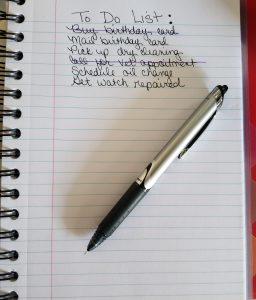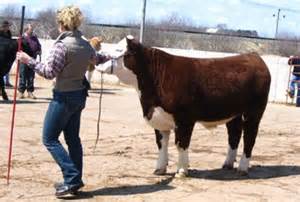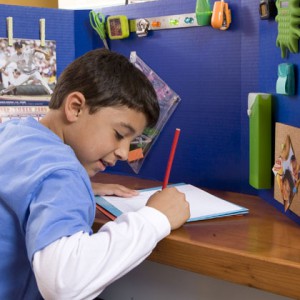by Niki Crawson | Dec 21, 2018
Did you know lack of organization in your life can affect not only your physical surroundings but also your physical and mental well-being? Clutter affects your ability to think, to focus, and even to relax. For children, having an organized space for homework allows for productivity and creativity. For adults, having an organized work space allows for productivity and efficiency. Having an organized home for children sets schedules and routines. For adults, having set schedules and routines make it easier to balance work, family time, and responsibilities such as financial planning and grocery shopping.
To start 2019 off on a positive note, let’s take a look at some easy ways you can get better organized for a better you in 2019.
1. SET GOALS
Goal-setting is an important life skill 4-H focuses on through the essential element, Independence. 4-Hers are taught goal-setting – an important tool that helps them state how, what, and when they are going to achieve something. To get started organizing and decluttering your home:
- Set 2-3 short-term goals
- Set 1-2 long-term goals
- Write them down – make them visible
Anything more than this will be too overwhelming and cause you to not start at all.
2. MAKE LISTS

Making a handwritten detailed to do list is important in staying organized.
Written lists are very important in accomplishing tasks. Most importantly, hand-written lists are more powerful than typed lists. Why? Handwriting requires more thought and motor skills which requires more cognitive and memory function. By having written to do lists, your memory can conjure up the tasks quickly and prioritize them with little effort even when the list is not directly in front of you. This allows you to plan your schedule to work on the list throughout the day, when time permits. In addition, writing lists allow the satisfaction of achievement. When you accomplish a task, cross it off the list and feel the sense of accomplishment that comes with getting things done.
3. DIVIDE AND CONQUER
One of the worst things you can do when attempting to organize a cluttered home is to look at the disorganized mess as a whole. This can be overwhelming, defeating and make you give up before you even get started! Don’t do this…instead, divide and conquer!
- Start by dividing your home into sections.
- Choose one room to start with.
- Start with just one section of that room – like the top of the dresser.
- Organize just that one area. Donate or sell any items you do not want or use.
Once you have organized your first area in that room, congratulate yourself and move to the next area. Begin the process again!
CUT CLUTTER WITH A CLOSE FRIEND
If you think getting organized is complicated, invite an organized friend over, and ask them to help. Organized individuals will help you stay on track, discard what you don’t need, and help you find a place for those random items you don’t know where to put. Some people just have a natural ability for organization, but for others, it’s just plain work.
ELIMINATE DUPLICATES
I’ve moved several times in recent years.The last time I was unpacking (for what I hope is my last move), I discovered I have nine hammers. Nine hammers!!! Apparently, each time I moved, I couldn’t find my hammer, so I just bought one. Over time, that gets expensive and takes up space. As you begin to organize and declutter, eliminate duplicates. Think about what you need and begin to downsize. You’ll be amazed at what you truly need versus what you think you need.
SAY GOODBYE…
If you haven’t used it in the last six months but don’t want to get rid of it just yet, box it up and label it with the date. If three months goes by and you don’t miss it, donate or sell it. Yard sales, selling apps or social media are a great way to make some extra money , BUT don’t hang on to it until you “get around to it….” Donate it to charity, or you’ll end up back in the cluttered mess you started with!
Simply taking the time now to put these few actions into place will help create a more efficient, better balanced and stress-free environment in the home and workplace. I hope that you find yourself healthier and happier in 2019!
To find out more information about 4-H programs that can offer essential life skills such as independence, organizational skills, and goal setting, to your children or to volunteer your time to work with children in your area, please contact your local UF/IFAS County Extension Office, or visit http://florida4h.org.
by Prudence Caskey | Jan 23, 2015

How Will You Make a Difference in 2015?
Let’s all take a big, deep breath…2014 is now a thing of the past! At this moment, we all have to decide what we are going to do in 2015. What will you resolve to do in the New Year? Will you finally use your elliptical for more than just a towel rack? Will you finally finish the book you were reading or that scrapbooking project? There are no limits to what you can accomplish in 2015 and in years to come.
I work with volunteers as the Santa Rosa County 4-H Agent. I know how much time it takes to volunteer and I understand the importance of my volunteers. As a very busy wife, mother, professional, graduate student, Children’s Church director and volunteer, I am often asked how I do it all. The easy answer is prioritize. The long answer is: I make lists, lots of lists! I have shopping lists, to do lists, countdown lists and lists of when my bills are due. Lists for birthdays and anniversaries. My most important list is my goal list. I write down my daily, weekly, monthly and annual goals. I break down my larger goals into smaller goals. I am a firm believer that if we can see it, we can do it!
Whatever you decide to set as a goal for 2015, I encourage you to make a difference. We all have something to offer. At the Extension Office, I meet people every day with something to offer the youth of our county. From those who have a passion for rabbits to those who love to cook and sew. On occasion, men will not offer their expertise, because they think they may not have much to offer. Believe me, showing the young people of our community how to check the oil in their cars, rotate their tires or even build a bookcase, are great life skills to pass on to our youth.
4-H volunteers are essential to help youth make the most of a wide variety of learning experiences. As a volunteer, you can share your personal interests and expertise in a variety of subjects including gardening, shooting sports, robotics, animal science, sewing/crafting, public speaking, foods and nutrition, and much more. In 4-H, you can leverage your experience and skills to help a young person find their own passions and interests.
You decide your level of involvement to fit your schedule:
- Lead youth in a community or project club, afterschool program, camp, or school group
- Serve as a chaperone, board member, judge, or camp counselor
- Develop and support service opportunities for youth to learn caring and compassion in your community
- Work with other volunteers to create fun and exciting programs to help youth in your community reach their full potential
4-H is an opportunity we wish every young person could have because research shows it is a step forward. More than 60 million of our nation’s most successful statesmen, business leaders, and scientists credit 4-H with setting them on a positive, productive path. When you share your experiences with 4-Hers, you make a difference by helping youth become caring and competent citizens. As you make goals for 2015, consider becoming a 4-H volunteer and inspire the next generation.
by Heather Kent | Oct 31, 2014
 For 4-H members and spectators alike, livestock shows are one of the most anticipated parts of a fair. Preparing your animal for a show begins months in advance. Great care is needed in feeding your animal, practicing showmanship, and making sure your animal is healthy. After all the time and effort that goes into raising your animal, you want to make sure that you have everything you need once you arrive at the fairgrounds.
For 4-H members and spectators alike, livestock shows are one of the most anticipated parts of a fair. Preparing your animal for a show begins months in advance. Great care is needed in feeding your animal, practicing showmanship, and making sure your animal is healthy. After all the time and effort that goes into raising your animal, you want to make sure that you have everything you need once you arrive at the fairgrounds.
Angel Granger, the 4-H Agent in Jackson County (also a former livestock club leader and 4-Her) suggests investing in a show box or rubber tote to keep all of your show supplies together.
Packing List for Large Animal Shows:
- Grooming tools- scotch comb, brush, shampoo, blower, clippers, scissors
- Feed supplies- feed, hay, buckets, feed tubs (rubber tubs work well)
- General supplies- water hose, spray nozzle, rubber boots, extension cord, extra rope, pitch fork, square point shovel, rake, and wheel barrow. Depending on the time of year, a fan is also a good idea (the temperature tends to change quickly in the fall and spring and can be unpredictable). Also pack a sign or poster about your animal (breed, age, name, sponsor, etc).
- General animal first-aid kit. Antibiotic cream/salve, aspirin boluses and balling gun, blood stop powder, and bleach. It is a good idea to disinfect the sand before you place your animal on the ring. A simple bleach mixture of 1 part bleach to 4 parts water, in a spray bottle will do.
- Show equipment. Show stick, show halter/lead, tie out halter and lead ropes.
Packing List for Small Animal Shows:
- Grooming tools (brush, comb, nail file, nail clippers, grooming apron or old clothes)
- Feed supplies- feed, feed containers, water bottle
- General supplies- bucket, rags, string or tie wire, sign for your animal (name, breed, age, sponsor, etc)
- General animal first aid kit.
- Show equipment- most dog shows require a leash.
Supplies needed for every show regardless of the species you are showing:
- Show clothes. There is no uniform for 4-H, but you will want to dress neatly and modestly. A button down shirt and dark pants are appropriate. A neck tie or 4-H bolero tie is a nice touch. Make sure your hair is neatly styled and pulled back away from your face. You may also want to bring some safety pins for your exhibitor tag.
- Human first aid kit- you can purchase one for less than $10.00, or put one together yourself (band aids, antibiotic ointment, pain reliever).
- Paperwork: A copy of the registration form you mailed/submitted, your animal’s health papers, your lease document (if applicable), and your ORIGINAL breed registry papers. Photocopies will not be accepted at check-in. It is a great idea to put these papers in a three-ring binder inside sheet protectors.
- Your knowledge and good sportsmanship! Be familiar with your animal so that you are prepared to answer any questions the judge may ask. Look over your feed record and record book. Remember to both win and lose gracefully.
Be sure to label your items with your name. Consider laminating your packing list and keeping it in your show box with a dry-erase marker. That way, you can check the items off as you load them into your box or trailer. Being prepared will help you be less nervous and make your experience much more enjoyable. See you at the fair!
by Heather Kent | Oct 3, 2014
 4-H Meetings should be fun for both the members and the volunteers. Club environments that cultivate belonging, mastery, independence, and generosity. Leading a 4-H club should be a fun and rewarding experience. Earlier this month, during our Make a Difference Monday Volunteer Leader Series, Tycee Prevatt shared some simple, but creative ideas to make club meetings fun, but also more manageable!
4-H Meetings should be fun for both the members and the volunteers. Club environments that cultivate belonging, mastery, independence, and generosity. Leading a 4-H club should be a fun and rewarding experience. Earlier this month, during our Make a Difference Monday Volunteer Leader Series, Tycee Prevatt shared some simple, but creative ideas to make club meetings fun, but also more manageable!
Divide your club into teams of 3-5 youth. Assign an older 4-Her (intermediate or teen) to serve as the team leader. This will not only make your club more manageable, but it also fosters leadership, teamwork, and cooperation- three essential skills for a happy and productive life.
How this works:
- Assign each team a color (buy inexpensive plastic tablecloths at the dollar store in each team color).
- Teams sit together during club meetings/functions. Parents sit behind the teams so as not to interfere.
- Teams can earn points for: attendance, being prepared for club meetings, being on time, doing a club demonstration, participating in a club service project, and attending 4-H events and activities beyond the club level (such as a day camp or canning workshop).
- As the leader, you can also use “pop quizzes” or project skill a thons to allow more opportunities to collect points. Parent can help with the skill a thon stations and your 4-H agent can help you set up a skill a thon. Stations can be project specific, such as naming the parts of a saddle, or they can be more general, such as reciting the 4-H pledge from memory or answering 4-H trivia questions.
It is important to set up a points system before introducing this to the club. This idea is really easy to adapt to any club situation. This example of a club points system is from a livestock club.
You will also need to decide on appropriate incentives. Some clubs give out a grand prize to the top team, others give prizes for 1st, 2nd, and 3rd teams. Ideas include: partial scholarships to 4-H camp, cash award, pizza or bowling party, or a fun field trip related to their project. Your club may need to do some fundraising to help pay for the prizes.
The team approach works well because it really encourages the members to attend the meetings on time and prepared. It helps motivate them to become more engaged. You will also have fewer interruptions or discipline issues, because teams can lose points for that! This approach works particularly well for medium to large clubs and can even be adapted for use during camp.
What are your best tips for making meetings fun? Let us know in the comment box below. Also, make plans to join us on October 20th for Make a Difference Monday at 7/6 central. Dr. Dale Pracht will be sharing how to create safe environments in our 4-H clubs. If you cannot make our live presentation, it will be archived along with this month’s presentation at http://florida4h.org/madmondays.
by Heather Kent | Aug 15, 2014

Photo courtesy of Family Fun Magazine
These days, children as young as kindergarten age can have homework. Getting your child to do homework during the hectic evening hours is frustrating for many busy parents, but setting up a simple homework center can make it easier.
- Select a location for your child to do homework- an eating nook in the kitchen or at the dining room table are good ideas. Try to keep your homework center location clutter free, and well lit. If you have younger children, they may need a booster seat in order for them to sit at the proper height for writing. Remember that children (even teens) need supervision and assistance with homework, so planning a homework area in a common location is more convenient so that parents can also work on other tasks such as preparing dinner. If the homework center is set up in a bedroom or loft space, you will need to plan on checking in from time to time to monitor their progress. Younger children or children with learning disabilities will need additional, or more frequent help.
- Gather Supplies– it is helpful to have a plastic cleaning caddy, tub, or recycled shoe box filled with supplies that your child might need for completing his homework, so that you don’t waste time looking for supplies each day. Recommended supplies include: pencils/pencil sharpener or mechanical pencils, erasers, colored pencils/markers, crayons, stapler/extra staples, index cards, highlighters, scotch tape, glue stick, dictionary, thesaurus, atlas or globe. Have your child decorate the caddy or box with stickers, paint, glitter glue, or other decorations.
- Limit Distractions– it is best to limit television and stereo/iPod during homework time. If you have more than one child, or a child with ADD/ADHD, you might also want to consider a study carrel. Study carrels limit distractions and help children focus on their work. Your child can help create a study carrel and customize it to his own needs with a tri-fold display board (readily available for less than $5.00 at office supply and big box stores). One display board will make two study carrels. Step by step instructions for creating one can be found online at: http://spoonful.com/crafts/homework-central courtesy of Family Fun Magazine.
- Set up a Reward System– reward your child for getting their homework completed in a timely and neat manner. You can set up a sticker system for earning small prizes, TV or video game time, or even to see an upcoming animated movie or for a family bowling night.
As your family prepares for back to school, don’t forget that the 4-H year will be coming to a close at the end of this month. Enrollment in Florida 4-H beings August 23rd. To re-enroll, visit: http://florida.4honline.com or contact your local UF/IFAS County Extension Office.
Next Week: School Lunch and Snack Ideas that are “Out of the Box”





